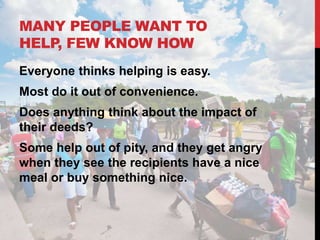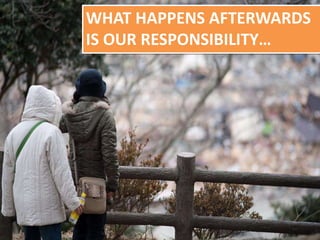Fail at helping - 2016
- 1. WHY WE FAIL AT HELPING BY ROBIN LOW
- 2. DEFINE HELP Help is any form of assistance. -- Wikipedia
- 3. WHY DO WE HELP? • Religion? • Good Intentions? • Guilt?
- 4. NEPAL EARTHQUAKE Twin Earthquakes 7.8 and 7.3 magnitude About 9,000 people killed 650,000 families displaced 600,000 homes destroyed beyond repair
- 5. DONATIONS Nepal received USD$4.1 billion from International Communities and World Bank. Guess what is progress at the 1 year anniversary?
- 6. REAL IMPACT IN NEPAL IN 2016 Some construction on infrastructure started. Some rebuilding on UNESCO sites. Number of homes rebuilt = 0
- 7. OTHER PROBLEMS • Political indecision (Nepal Reconstruction Agency) • Unofficial Blockade on Indian border • PUSHING OF BLAME • WAITING FOR HELP
- 8. RESULTS • People died from exposure from environment. • People displaced living in tents • Farmers living in tents on their farms, reduced income and food. • Jobs lost (no Fuel) • Unequal distribution of support.
- 9. SINGAPORE HELP Students from Singapore visited Nepal and distributed aid. Supported by Mega Churches, what can go wrong?
- 10. SINGAPORE HELP Students decided not to leave Kathmandu, and just deliver aid in Kathmandu. They discovered bibles in blankets. (Common practice in Relief) They “helped” to remove it.
- 11. RESULTS What do you think when a majority Buddhist / Hindu country finds lots of bibles in their capital?
- 12. MANY PEOPLE WANT TO HELP, FEW KNOW HOW Everyone thinks helping is easy. Most do it out of convenience. Does anything think about the impact of their deeds? Some help out of pity, and they get angry when they see the recipients have a nice meal or buy something nice.
- 13. CURSE OF EXCLUSION OF LOCALS IN DISASTER RELIEF AND RECOVERY
- 14. CAN HAITIANS DRIVE? Haiti Earthquake 2010 Food donation & delivery. Trucks of Aid to Port-au-Prince. 5 year old saw the dominican driver and asked, “Can Hatians Drive?”
- 15. STATISTICS 50% of world live on less than US$2.50 a day (> 3 Billion People)
- 16. STATISTICS 80% of world live on less than US$10 a day 80% of world live in countries with increased income disparity. The poorest 40 percent of the world’s population accounts for 5 percent of global income. The richest 20 percent accounts for three-quarters of world income. According to UNICEF, 22,000 children die each day due to poverty. And they “die quietly in some of the poorest villages on earth, far removed from the scrutiny and the conscience of the world. Being meek and weak in life makes these dying multitudes even more invisible in death.”
- 17. HOW LONG HAVE WE BEEN DOING THIS? How long have charities been doing the things they are doing? Is anything changing?
- 18. SCHOOL REBUILDING Singaporean students decided to rebuild a school that collapsed in Kathmandu. Raised funds, bought materials and talked to a school to help rebuild the building.
- 19. IS CONSTRUCTION LOW SKILLED JOB Do you think you can rebuild a school structure with cement, cinder blocks, Metal bars and a zinc roof? Can you learn this from the Internet?
- 20. RESULTS Good intentions, not so good outcome.
- 21. Is helping any help? Not really… At least not in the way we are doing it…
- 22. Often when we help… We make life decisions for those we are helping.
- 23. Often when we help… We fail to see the whole picture and feel content to help.
- 24. Often when we help… We search the approach most efficient to us not to those we are trying to help.
- 25. Often when we help… We destroy the very same environment we are trying to help.
- 26. Often when we help… we displace local capacity.
- 27. Often when we help… we measure our success by the delivery of help or completion of actions not actual impact.
- 28. WHAT HAPPENS WHEN DISASTER STRIKES IS AN UNFORTUNATE TWIST OF FATE.
- 29. WHAT HAPPENS AFTERWARDS IS OUR RESPONSIBILITY…
- 30. When disaster strikes… Some people are given a burden: The burden of enduring the disaster and the conditions that follow
- 31. When disaster strikes… Some people are given a gift: The gift of being spared from disaster.
- 32. How can we not use our gift to lift the burden of others?
- 33. Disaster Response Lies… • Only experts can help. • You will be a burden in the field. • We don’t need anything, we have all we need. • Do not send clothes or food, send money.
- 34. We all can respond… • And guarantee an efficient response… • Donate Action, not money, not words… • But how?
- 35. Disaster Response Basics: You can be useful in the field if… • Bring your own supplies and food to the field. – Or buy them locally if possible. • Engage the local stakeholders and work for them, with them. • Are connected. • Have independent mobility. • Listen, learn, respect.
- 36. Relief 2.0 (what is it?) • A focus on running the last mile in disaster relief • through independent units of local stakeholders and foreign volunteers in the field • supported by mobile technologies and social networks • to fill the gaps created by bureaucracy and slow response from top-down hierarchies.
- 37. Relief 2.0 (how does it work?) • Individuals and organizations report incidents, needs and requests from the field using their mobile phones and the Internet.
- 38. Relief 2.0 (how does it work?) • These incidents are reviewed, verified, completed, enhanced and their information spread to others by individuals and groups on social networks – Housewives, youngsters, volunteers, anyone. until they are addressed, solved or matched with someone who takes care of it.
- 39. Relief 2.0 (the last mile) • Small independent units then complete the cycle by actually addressing those issues and delivering the response required and supported by the social network.
- 41. When disaster strikes… The social infrastructure remains, people’s capacity is untouched…
- 42. What appears to be random or chaos is neither…
- 43. There is order, social structure…
- 44. There is people, like you and me, willing and able.
- 45. Who are the people who survive disaster?
- 46. Disasters create survivors, they don’t create refugees. It is the conventional relief system what turns survivors into refugees.
- 47. Disasters do not destroy knowledge or capacity Teachers are still teachers, doctors are still doctors, nurses are still nurses, carpenters are still carpenters…
- 48. DANGERS OF SOCIAL INTERVENTION Making life decisions for those we are helping Is there “Over Helping?”
- 49. ARE YOU HELPING? Should you do nothing? Should you support status quo?
- 50. SO THEN WHAT CAN WE DO?
- 52. Disaster recovery with dignity, inclusion, generation and distribution of wealth Businesses working with businesses to get back on track and jumpstarting the economy to serve people
- 53. Matching shops and businesses affected by disaster with same-trade businesses in non-affected areas and enable collaboration to get businesses to re-open as soon as possible. Relief 2.0 B2B
- 54. It’s not charity, it’s not donation. Both businesses reach a collaborative business agreement: 36 mth low interest loan, restore inventory, line of credit, etc. It’s a business deal that preserves their dignity. Relief 2.0 B2B
- 55. Relief 2.0 Enterprise We need to start working with disaster survivors and enable them as entrepreneurs before they are turned into refugees by conventional relief.
- 56. Matching Co-ops from Villages to Local Business Organizations. Buying van to transport injured to hospitals, and crops to market. Repaying with agreed upon fair priced barter trade. Connecting farmers to markets directly. Relief 2.0 B2V
- 58. “Philanthropy dollar” can only be used once, the “social dollar” can be used again and again. -- Muhammad Yunus
- 59. ART IMPACT NEPAL Leveraging on Arts for Disaster Recovery. • Sell art to raise funds to build art studio. • Teach earthquake survivors to make handicrafts. • Sell handicrafts to increase income for survivors. • Run international shows to find overseas market. • Create awareness for Nepal products • Build residential art studios to allow foreign artists to come support survivors to learn and teach art.
- 60. SOLAR FORWARD
- 61. SOLAR FORWARD Pay it forward model to bring solar panels to rural areas and earthquake survivors. Top income generators (people with second job) will be given solar kit with responsibility Light allows them to be more productive and 4 more hours of light can allow more income.
- 62. SOLAR FORWARD Saving $1 a day, recipients can buy a solar kit for someone else in 2 months, enabling them to provide for others what was given to them. Eventually, whole village can have light.
- 63. SOLAR FORWARD Monitor success, learn from village dynamics. Getting NGOs and Foundations to support, give guarantee for other villagers. They can pay via installments from regular banks, US$0.30 a day for 6 months at 10% interest. They can build up credit and be integrated into baking system.
- 64. There are so many new problems happening everyday. Complaining does not solve problems, protesting does not solve problems. There is only so much the government or NGOs can do. Being big and bureaucratic allows them to act fast and raise lots of funds, but they are slow to respond to changes. We need innovation and people to take actions and accountability. We all live on the sample planet.
































































